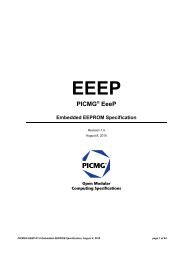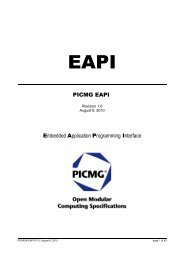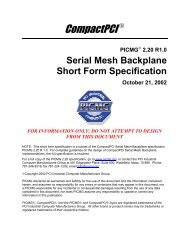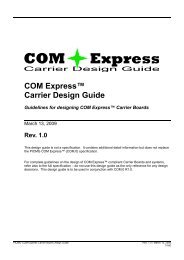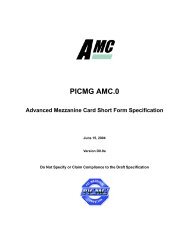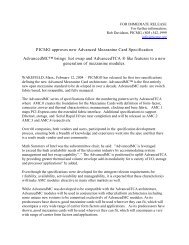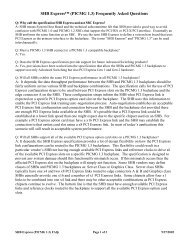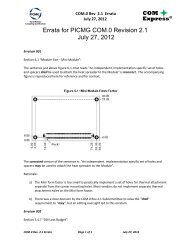PICMG 2.16, CompactPCI Packet Switching Backplane
PICMG 2.16, CompactPCI Packet Switching Backplane
PICMG 2.16, CompactPCI Packet Switching Backplane
Create successful ePaper yourself
Turn your PDF publications into a flip-book with our unique Google optimized e-Paper software.
<strong>CompactPCI</strong> ®<br />
<strong>PICMG</strong> ® <strong>2.16</strong> Revision 1.0<br />
<strong>Packet</strong> <strong>Switching</strong> <strong>Backplane</strong><br />
Short Form Specification<br />
September 5, 2001<br />
FOR INFORMATION ONLY; DO NOT ATTEMPT TO DESIGN<br />
FROM THIS DOCUMENT<br />
NOTE: This short form specification is a subset of the <strong>CompactPCI</strong> <strong>Packet</strong> <strong>Switching</strong> <strong>Backplane</strong><br />
specification, <strong>PICMG</strong> <strong>2.16</strong> R 1.0. For complete guidelines on the design of <strong>CompactPCI</strong> <strong>Packet</strong><br />
<strong>Switching</strong> <strong>Backplane</strong> implementations, the full specification is required.<br />
For a full copy of the <strong>PICMG</strong> <strong>2.16</strong> specification, go to www.picmg.org, or contact the PCI Industrial<br />
Computer Manufacturers Group at 401 Edgewater Place, Suite 500, Wakefield, Mass., 01880. Phone<br />
781-246-9318, fax 781-224-1239, email info@picmg.org.<br />
©Copyright 2001 PCI Industrial Computer Manufacturers Group.<br />
<strong>PICMG</strong> disclaims all warranties and liability for the use of this document and the information contained herein, and<br />
assumes no responsibility for any errors or omissions that may appear in this document, nor is <strong>PICMG</strong> responsible<br />
for any incidental or consequential damages resulting from the use of any data contained in this document, nor does<br />
<strong>PICMG</strong> assume any responsibility to update or correct any information in this publication.<br />
<strong>PICMG</strong>®, <strong>CompactPCI</strong>®, and the <strong>PICMG</strong>® and <strong>CompactPCI</strong>® logos are registered trademarks of the PCI<br />
Industrial Computer Manufacturers Group.<br />
All other brand or product names may be trademarks or registered trademarks of their respective holders.
<strong>PICMG</strong> ® <strong>2.16</strong> R1.0 Short Form Specification<br />
INTRODUCTION<br />
Ethernet network technology continues to be incorporated into more products than ever before.<br />
Once networked, components are relatively easy to integrate, allowing acceleration of system<br />
development.<br />
Existing network technology is naturally bridged by networked components, thus providing<br />
unparalleled system scalability. The continued ability of products to interoperate is essential to<br />
the timely development and evolution of systems in a changing world. Opportunities remain for<br />
improving the rapid integration of products that will continue to adapt to the special needs of the<br />
industry.<br />
The <strong>CompactPCI</strong> <strong>Packet</strong> <strong>Switching</strong> <strong>Backplane</strong> (<strong>CompactPCI</strong>/PSB) is an extension to the <strong>PICMG</strong><br />
2.x family of specifications that overlays a packet-based switching architecture on top of<br />
<strong>CompactPCI</strong> to create an Embedded System Area Network (ESAN). It supplements the robust,<br />
reliable and hot-swap capable <strong>CompactPCI</strong> architecture with the easily integrated, low-cost,<br />
high-performance, and extensible Ethernet. This creates a platform well suited to the integration<br />
of components for the most demanding systems and empowers system integration and design to<br />
ascend to higher layers of the Open Systems Interconnection (OSI) protocol stack, thus reducing<br />
system integration time.<br />
Objectives of the <strong>CompactPCI</strong> <strong>Packet</strong> <strong>Switching</strong> <strong>Backplane</strong><br />
The objective of the <strong>CompactPCI</strong>/PSB Specification is to define an IEEE 802.3-2000<br />
1000BASE-T compliant packet switching backplane to supplement the existing suite of <strong>PICMG</strong><br />
2.x Specifications. This provides designers, manufacturers, and integrators with a common<br />
platform for implementing an ESAN that provides all the benefits of a Local Area Network<br />
(LAN) in an embedded system environment. An ESAN can provide high-availability by<br />
providing redundancy in both interconnections and switching components.<br />
Use of IEEE 802.3-2000 provides an industry-standard framework for network communication<br />
within the chassis that inherently follows the rules set forth in the OSI Reference Model (see<br />
Figure 1). OSI divides network communications processes into seven components called layers.<br />
Every layer consists of protocols for communicating with the preceding and succeeding layers.<br />
The <strong>CompactPCI</strong>/PSB Specification leverages IEEE 802.3-2000 1000BASE-T in providing the<br />
physical and data link layers. Protocol stacks such as TCP/IP can be added at the network and<br />
transport layers to provide a reliable connection-oriented environment.<br />
Application<br />
Presentation<br />
Session<br />
Transport<br />
Network<br />
Data Link<br />
Physical<br />
Figure 1 OSI Reference Model<br />
FOR INFORMATION ONLY;<br />
DO NOT ATTEMPT TO DESIGN FROM THIS DOCUMENT
<strong>PICMG</strong> ® <strong>2.16</strong> R1.0 Short Form Specification<br />
<strong>CompactPCI</strong>/PSB is bit-rate scalable; a single pinout supports a physical interface at rates of 10,<br />
100, or 1000 Mbps on a slot-by-slot basis (up to two links per slot). The <strong>CompactPCI</strong>/PSB<br />
supports full-duplex bit rates of up to 2000 Mbps per slot. A twenty-one slot PSB supports a<br />
total bandwidth approaching 40 Gbps. Redundant switching fabrics allow for the creation of<br />
High Availability (HA) systems. Connector and connector pin utilization is minimized (16<br />
active pins on P3/J3), thus allowing all <strong>PICMG</strong> 2.x Specifications to coexist on P1/J1, P2/J2,<br />
P4/J4, and P5/J5, with the exception of <strong>PICMG</strong> 2.3, because it has not been developed to support<br />
differential pair signaling.<br />
The <strong>CompactPCI</strong>/PSB includes well-defined subsets so that economical low-end systems can be<br />
built. A twenty-one slot backplane can be scaled from 10 to 1000 Mbps per port, one to two<br />
ports per slot; two to nineteen (Node) slots per chassis; and one to two purpose-built (Fabric)<br />
slots.<br />
PACKET SWITCHING BACKPLANE OVERVIEW<br />
A <strong>Packet</strong> <strong>Switching</strong> <strong>Backplane</strong> is composed of Node Slots, Fabric Slots, and the Links that<br />
interconnect them. The PSB topology is a star (not a bus) as shown in Figure 2. Each line<br />
interconnecting a Node Board and Fabric Board represents a Link that is a 10/100/1000 Mbps<br />
full-duplex Ethernet connection. Node Boards communicate by transferring/receiving packets<br />
to/from the Fabric Board, which transfers the packet to/from one or more Node Boards. Thus,<br />
every Node Board can communicate with every other Node Board and form a fabric.<br />
NODE<br />
NODE<br />
NODE<br />
NODE<br />
NODE<br />
NODE<br />
NODE<br />
NODE<br />
FABRIC<br />
SWITCH<br />
BOARD<br />
SWITCH<br />
NODE<br />
NODE<br />
NODE<br />
NODE<br />
NODE<br />
NODE<br />
NODE<br />
NODE<br />
Figure 2 Single Fabric PSB Topology<br />
Figure 3 shows the physical interconnections after adding a second switch to the system and a<br />
second Link Port to each Node. Two Link Ports of a single Node Board are wired to each of the<br />
two Fabric Boards. An optional Link is defined between Fabric ‘a’ and Fabric ‘b’ that is<br />
10/100/1000 Mbps capable.<br />
FOR INFORMATION ONLY;<br />
DO NOT ATTEMPT TO DESIGN FROM THIS DOCUMENT
<strong>PICMG</strong> ® <strong>2.16</strong> R1.0 Short Form Specification<br />
NODE<br />
NODE<br />
NODE<br />
NODE<br />
NODE<br />
NODE<br />
FABRIC<br />
SWITCH<br />
BOARD<br />
SWITCH<br />
NODE<br />
NODE<br />
FABRIC<br />
SWITCH<br />
BOARD<br />
SWITCH<br />
NODE<br />
NODE<br />
NODE<br />
NODE<br />
NODE<br />
NODE<br />
Figure 3 Dual Fabric PSB Topology<br />
Figure 4 shows a 19” chassis example. Chassis may support more or less than 21 slots. Fabric<br />
Slots may be located in any slot of the <strong>Packet</strong> <strong>Switching</strong> <strong>Backplane</strong>.<br />
NODE<br />
NODE<br />
NODE<br />
NODE<br />
NODE<br />
NODE<br />
NODE<br />
NODE<br />
NODE<br />
NODE<br />
NODE<br />
NODE<br />
NODE<br />
NODE<br />
NODE<br />
NODE<br />
NODE<br />
NODE<br />
NODE<br />
FA B R IC 'a'<br />
FA B R IC 'b'<br />
Node Slot Overview<br />
Node Slot(s):<br />
1 2 3 4 5 6 7 8 9 10 11 12 13 14 15 16 17 18 19 20 21<br />
Figure 4 Node/Fabric Slot Example<br />
• Contain PSB Node Boards connected to one Fabric (‘a’) or both<br />
PSB Fabrics (‘a’ and ’b’).<br />
• Connections between Node Slots and Fabric Slots are via Links.<br />
• Up to 19 Node Slots may be supported in a 19” <strong>CompactPCI</strong>/PSB backplane.<br />
• A Node Slot may support 1 Link Port (‘a’) or 2 Link Ports (‘a’ and ‘b’), each<br />
@10/100/1000Mbps.<br />
• Connection from each Node Slot to the <strong>CompactPCI</strong>/PSB Fabric Slot (‘a’ and ‘b’) is done<br />
via 16 active J3/P3 pins.<br />
• Available bandwidth for each Node Slot can be up to 4 Gbps.<br />
FOR INFORMATION ONLY;<br />
DO NOT ATTEMPT TO DESIGN FROM THIS DOCUMENT
<strong>PICMG</strong> ® <strong>2.16</strong> R1.0 Short Form Specification<br />
Fabric Slot Overview<br />
Fabric Slot(s) (‘a’ and ‘b’):<br />
• Contain PSB Standard Fabric Boards connected with 1 to 19 PSB Links.<br />
• Contain PSB Extended Fabric Boards connected with 20 to 24 PSB Links.<br />
• Fabric Boards in Fabric Slots switch packets between multiple Node Slots.<br />
• Connections between Fabric Slots and Node Slots are via Links.<br />
• A Standard Fabric Slot may support between 1 and 19 Links, each @10/100/1000 Mbps.<br />
• An Extended Fabric Slot may support between 20 and 24 Links, each @10/100/1000 Mbps.<br />
• Up to 2 Fabric Slots may be supported in a <strong>CompactPCI</strong>/<strong>Packet</strong> <strong>Switching</strong> <strong>Backplane</strong>.<br />
• Connection to the Standard Fabric Slot(s) is done via 152 active J3/P3, and J5/P5 pins.<br />
• Connection to the Extended Fabric Slot(s) is done via 192 active J3/P3, J4/P4, and J5/P5<br />
pins.<br />
• Available bandwidth for each Standard Fabric Slot can be up to 20 Gbps (40 Gbps fullduplex).<br />
• Available bandwidth for each Extended Fabric Slot can be up to 25 Gbps (50 Gbps fullduplex).<br />
• Link Port ‘f’ supports an optional Fabric ‘a’ to Fabric ‘b’ connection.<br />
Link Port Overview<br />
Figure 5 shows how Link Ports are defined for Node and Fabric Slots/Boards.<br />
Row<br />
10/100 Mbps<br />
N+1<br />
N<br />
GND<br />
Tx<br />
+ - + BI_DC -<br />
BI_DA<br />
GND<br />
Rx<br />
+ - + BI_DD -<br />
BI_DB<br />
1000 Mbps<br />
A B C D<br />
E<br />
Column<br />
Link Overview<br />
Figure 5 Link Ports for Node and Fabric Slots/Boards<br />
Figure 6 shows an example of a 6-slot Dual Fabric <strong>Packet</strong> <strong>Switching</strong> <strong>Backplane</strong>.<br />
FOR INFORMATION ONLY;<br />
DO NOT ATTEMPT TO DESIGN FROM THIS DOCUMENT
<strong>PICMG</strong> ® <strong>2.16</strong> R1.0 Short Form Specification<br />
Node Boards<br />
Plug Into<br />
Node<br />
Slots<br />
Fabric Boards<br />
Plug Into<br />
Fabric<br />
Slots<br />
Fabric 'f' Link<br />
8 wire IEEE 802.3-2000 Compliant<br />
Fabric 'a' Links<br />
8 wire IEEE 802.3-2000 Compliant<br />
1 2 3 4 a b<br />
f f<br />
1 1<br />
Fabric Board<br />
Link Ports<br />
1 to N, and 'f'<br />
Node Board<br />
Link Ports<br />
'a' and 'b',<br />
a a a a<br />
b b b b<br />
2<br />
3<br />
4<br />
2<br />
3<br />
4<br />
Fabric 'b' Links<br />
8 wire IEEE 802.3-2000 Compliant<br />
Figure 6 Node/Fabric Slot Interconnect Example (6 Slots)<br />
Link Port ‘a’ of each Node Slot is connected to a Link Port of Fabric Slot ‘a’. Link Port ‘b’ of<br />
each Node Slot is connected to a Link Port of Fabric Slot ‘b’. Link Ports of Node Slot N are<br />
connected to Link Port N of Fabric Slots ‘a’ and ‘b’.<br />
Hot Swap Interoperability<br />
The <strong>CompactPCI</strong>/PSB Specification supports Hot Swap in several ways. <strong>PICMG</strong> <strong>2.16</strong> Boards<br />
and <strong>Packet</strong> <strong>Switching</strong> <strong>Backplane</strong>s may support only <strong>CompactPCI</strong>/PSB Link Ports or both the<br />
<strong>CompactPCI</strong> Bus and the <strong>CompactPCI</strong>/PSB Link Ports.<br />
A new signal, PCI_PRESENT#, is defined for use by <strong>CompactPCI</strong>/PSB Boards. This signal is<br />
allocated to the P1/J1 connector on pin B6. P1-B6 is defined as ground (GND) in <strong>PICMG</strong> 2.0<br />
R3.0. PCI_PRESENT# serves two purposes. It allows a board’s <strong>CompactPCI</strong> Bus interface to<br />
be appropriately configured when the <strong>CompactPCI</strong> Bus is not connected to the corresponding<br />
slot. In a Hot Swap environment, it partially determines when the board must locally manage the<br />
handle switch, Blue LED, ENUM# and quiescence of critical board resources. When low, this<br />
active-low signal indicates that the <strong>CompactPCI</strong> Bus signals are connected to the corresponding<br />
slot.<br />
The complete <strong>2.16</strong> specification defines <strong>CompactPCI</strong>/PSB Hot Swap requirements for<br />
<strong>Backplane</strong>s, Node Boards and Fabric Boards with Hot Swap capabilities. A <strong>CompactPCI</strong>/PSB<br />
Hot Swap Board can support only <strong>CompactPCI</strong>/PSB Link Ports or both the <strong>CompactPCI</strong> Bus<br />
and the <strong>CompactPCI</strong>/PSB Link Ports. A <strong>Packet</strong> <strong>Switching</strong> <strong>Backplane</strong> Slot can support only<br />
<strong>CompactPCI</strong>/PSB Links or both a <strong>CompactPCI</strong> Bus and the <strong>CompactPCI</strong>/PSB Links.<br />
<strong>PICMG</strong> <strong>2.16</strong> supports a superset of the High Availability functionality defined by <strong>PICMG</strong> 2.1.<br />
Not every implementation of <strong>PICMG</strong> <strong>2.16</strong> <strong>CompactPCI</strong> <strong>Packet</strong> <strong>Switching</strong> <strong>Backplane</strong>s or<br />
<strong>CompactPCI</strong>/PSB Hot Swap Node/Fabric Boards is necessarily interoperable with <strong>PICMG</strong> 2.1<br />
defined High Availability components.<br />
FOR INFORMATION ONLY;<br />
DO NOT ATTEMPT TO DESIGN FROM THIS DOCUMENT
<strong>PICMG</strong> ® <strong>2.16</strong> R1.0 Short Form Specification<br />
Node Board J3 Pin Assignment<br />
The following table is provided for reference only and must not be considered adequate for<br />
design purposes. A proper understanding of isolation requirements, pin usage requirements, etc<br />
is necessary in order to create a <strong>PICMG</strong> <strong>2.16</strong> compliant product.<br />
Node Board J3 Pin Assignment<br />
19 GND BP(I/O) BP(I/O) BP(I/O) BP(I/O) BP(I/O) GND<br />
18 GND LPa_DA+ LPa_DA- GND LPa_DC+ LPa_DC- GND<br />
17 GND LPa_DB+ LPa_DB- GND LPa_DD+ LPa_DD- GND<br />
16 GND LPb_DA+ LPb_DA- GND LPb_DC+ LPb_DC- GND<br />
15 GND LPb_DB+ LPb_DB- GND LPb_DD+ LPb_DD- GND<br />
14 GND BP(I/O) BP(I/O) BP(I/O) BP(I/O) BP(I/O) GND<br />
13 GND BP(I/O) BP(I/O) BP(I/O) BP(I/O) BP(I/O) GND<br />
12 GND BP(I/O) BP(I/O) BP(I/O) BP(I/O) BP(I/O) GND<br />
11 BP(I/O) BP(I/O) BP(I/O) BP(I/O) BP(I/O)<br />
10 BP(I/O) BP(I/O) BP(I/O) BP(I/O) BP(I/O)<br />
9 BP(I/O) BP(I/O) BP(I/O) BP(I/O) BP(I/O)<br />
8 GND BP(I/O) BP(I/O) BP(I/O) BP(I/O) BP(I/O) GND<br />
7 GND BP(I/O) BP(I/O) BP(I/O) BP(I/O) BP(I/O) GND<br />
6 GND BP(I/O) BP(I/O) BP(I/O) BP(I/O) BP(I/O) GND<br />
5 GND BP(I/O) BP(I/O) BP(I/O) BP(I/O) BP(I/O) GND<br />
4 GND BP(I/O) BP(I/O) BP(I/O) BP(I/O) BP(I/O) GND<br />
3 GND BP(I/O) BP(I/O) BP(I/O) BP(I/O) BP(I/O) GND<br />
2 GND BP(I/O) BP(I/O) BP(I/O) BP(I/O) BP(I/O) GND<br />
1 GND BP(I/O) BP(I/O) BP(I/O) BP(I/O) BP(I/O) GND<br />
Pin Z A B C D E F<br />
J3 Connector<br />
###<br />
FOR INFORMATION ONLY;<br />
DO NOT ATTEMPT TO DESIGN FROM THIS DOCUMENT




